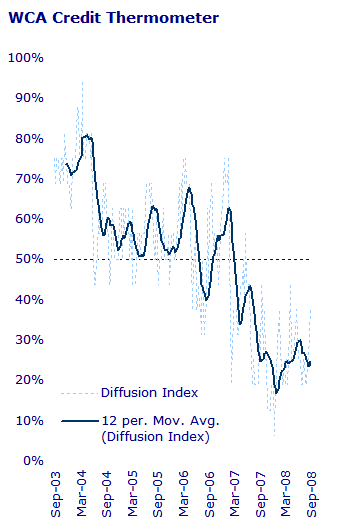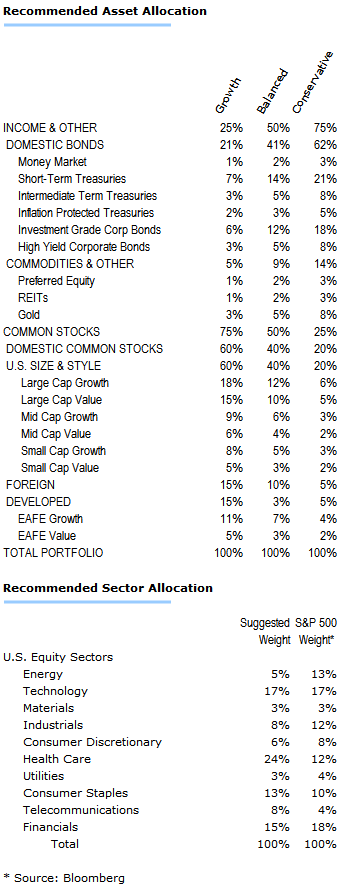Downgrading Outlook Based on Credit Freeze
We have re-evaluated our portfolio posture in light of new
information that suggests the current downturn in the
economy may persist longer than even our original
recessionary forecast. We now know, based on new data
from the
Federal Reserve, that credit creation in the United
States effectively seized in the second quarter as net
new borrowing by households fell to $197 billion. This
level of credit creation is $750 billion less than a year
ago and $1.2 trillion less than the peak levels seen two
years ago. Said another way, the current annualized
growth rate in credit, at 1.4%, is the lowest growth rate
for this statistic on record, with data going back to 1952.
Even those growth rates for government and business have
slowed materially in recent quarters, leaving total
borrowing growth near 3.5% — a level not seen since 1991.
In short, we believe that the massive increase in leverage
from 2000-2006 that occurred at both the household level and
within the financial system must now be reduced. With
aggregate U.S. household debt-to-income ratios near 140% and
some large financial firms' asset leverage ratios near
30-40X equity, the current stresses in the economy now will
likely require forced liquidation of assets over time that
may result in further downward pressure on asset prices and
may cause both corporate and individual borrowers to seek to
adopt a more risk-averse, and more liquid, posture.
While we had been hopeful that the current slump in the
economy would follow earlier cycles, we now must confront
the cold facts that directly point toward de-leveraging and
asset price deflation. As a result, we have adjusted
our investment posture and recommended tactical asset
exposure to recognize these new facts. The changes
made to our recommended allocations do three things:
Raise more cash: Reduce portfolio risk exposure
in light of the above facts and increase potential buying
power in the event of further market declines.
More evenly distribute U.S. equity portfolio:
Create a more even distribution of U.S. common equity
exposure by increasing the relative exposure to smaller and
value segments of the markets within portfolios. We
also acknowledge the emerging leadership of small
capitalization stocks in recent months, and we are
recognizing the relative shift in valuations that have
occurred between growth and value over the past year.
Reduce exposure to higher volatility foreign markets: We
are broadening our exposure within the developed markets and
continue to avoid emerging and BRIC economies.
While we expected to see an improving credit environment by
now, this is simply not the case. Our original work on
credit cycles, that suggests that economies and markets have
become increasingly tied to trends in credit creation
(versus traditional inventory adjustment models), remains
valid in our view. Therefore, we now are formalizing
our analysis on credit trends and relating these trends to
our tactical recommendations for asset allocation. To
help with this, we are introducing a new indicator for
monitoring changes in credit markets and their impact on the
economy. This index combines a variety of
forward-looking and real-time market inputs that we believe
are relevant to today's credit conditions. In short,
it can be thought of as a thermometer that gauges whether
the current credit environment is warming up or becoming
more deeply frozen. It also provides us with a
quantitative and unbiased measure for assessing and
benchmarking our overall equity exposure in the weeks and
months ahead.
We will refer to this diffusion-style indicator in the
future as we discuss our top-down tactical asset allocation
decisions. As you can see from the chart below, the
composite takeaway is that conditions remain more hostile to
risk-taking at this time than during the 2003-2006
timeframe. Further deterioration could suggest that
even greater cuts in equity exposure are warranted, while
improvement could suggest that additions to equity exposure
are becoming more appropriate. These observations will
continue to be an important contributor to our overall
outlook for financial markets given the special set of
conditions now confronted by financial markets.

There are many inputs to the index. In general, they
are designed to be relevant to today's highly unusual set of
financial conditions. The index seeks to take a
week-to-week and month-to-month point of view rather than a
day-to-day point of view. In addition, the inputs are
intended to give us forward-looking information that may
directly impact the outlook for the economy and equity
markets. This index is a diffusion-style index
comprised of several equally weighted components. The
components include:
Libor-OIS Spread: An indicator of the banking
systems' ability to get short-term funding from one another.
Term Spread: Represents the difference between
long-term U.S. government interest rates and short-term cost
of funding for banks. A widening spread typically
signals an improving environment for banks who traditionally
seek to profit from "borrowing short" and "lending long."
Treasury / Moody's Baa Spread: An indicator of
credit risk among domestic industrial companies.
Homebuilders Index Relative Performance: A
market-based indicator focused on housing.
Financial Sector Index Relative Performance: A
market-based indicator focused on banking and finance.
Stock / Bond Relative Performance: A measure of
sentiment and risk preference among investors.
Trade-Weighted Performance of Dollar: Measures
perceptions about the health of the U.S. economy.
Weekly Jobless Claims: A weekly indicator that
reflects the health of the overall economy from the
viewpoint of employment.
At present, we conclude that credit conditions remain poor.
We will continue to monitor these and other inputs and make
changes accordingly to our recommended tactical asset
allocation exposures in the weeks and months ahead.
 |
Past Commentaries
September 15, 2008
Equity Markets Stumble on Lehman, Merrill, and AIG
More
September 9, 2008
No Change In Strategy On GSE Action
More
July 31, 2008
Quick Take on GDP Report
More
July 21, 2008
Valuation Are Better, But Markets Are Not Out of the
Woods
More
May 20, 2008
Buy the Dips
More
March 10, 2008
Investing During Recession
More
January 22, 2008
Global Sell-off
More
December 27, 2007
Outlook 2008
More
December 7, 2007
NBER President Raises Recession Concerns
More
November 28, 2007
Equity Risk Heightened - Allocation Remains Defensive
More
September 25, 2007
After the Rate Cut
More
July 30, 2007
The Case For Growth
More
June 15, 2007
Data Affirms Tactical Asset Allocation Posture
More
March 19, 2007
Cutting Earnings And Equity Target
More
| |
To unsubscribe, please click here.
Company Name, Address and Contact Details
The information contained herein has been prepared from sources believed to be
reliable but is not guaranteed by us and is not a complete summary or statement
of all available data, nor is it considered an offer to buy or sell any
securities referred to herein. Opinions expressed are subject to change without
notice and do not take into account the particular investment objectives,
financial situation, or needs of individual investors. There is no guarantee
that the figures or opinions forecasted in this report will be realized or
achieved. Employees of Stifel, Nicolaus & Company, Incorporated or its
affiliates may, at times, release written or oral commentary, technical
analysis, or trading strategies that differ from the opinions expressed within.
Past performance is no guarantee of future results. There are special
considerations associated with international investing, including the risk of
currency fluctuations and political and economic events. Investing in emerging
markets may involve greater risk and volatility than investing in more developed
countries. Due to their narrow focus, sector-based investments typically exhibit
greater volatility. Small company stocks are typically more volatile and carry
additional risks, since smaller companies generally are not as well established
as larger companies. Property values can fall due to environmental, economic, or
other reasons, and changes in interest rates can negatively impact the
performance of real estate companies. When investing in bonds, it is important
to note that as interest rates rise, bond prices will fall. High-yield bonds
have greater credit risk than higher quality bonds. The risk of loss in trading
commodities and futures can be substantial. You should therefore carefully
consider whether such trading is suitable for you in light of your financial
condition. The high degree of leverage that is often obtainable in commodity
trading can work against you as well as for you. The use of leverage can lead to
large losses as well as gains. Indices are unmanaged, and you cannot invest
directly in an index.
Stifel, Nicolaus & Company, Incorporated | Member SIPC & NYSE |
www.stifel.com |